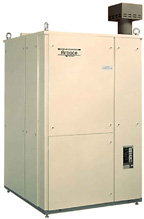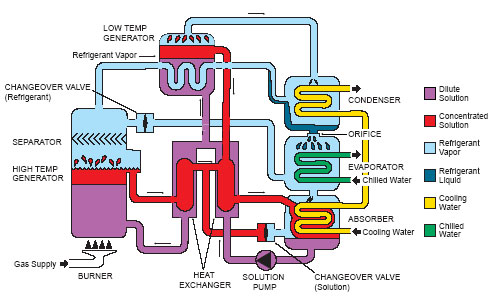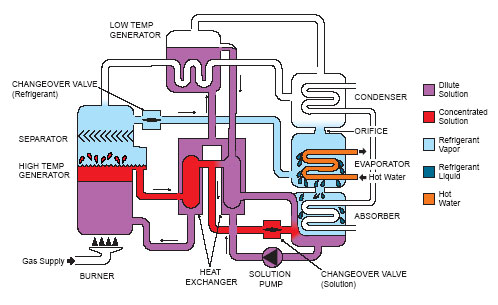

Gas Fired Double-Effect Chiller-Heaters
CH-MG Series: 150 and 200 RT Cooling Capacities
How They Work
Yazaki MG-Series gas-fired DOUBLE-EFFECT chiller-heaters, with cooling capacities of 150 and 200 tons of refrigeration, are designed for commercial applications where chilled water and hot water are used in a central air conditioning system. The condenser is water cooled and heat is rejected through a cooling tower.
- Absorption Principle:
- The Yazaki absorption chiller-heater uses a solution of lithium bromide and water, under a vacuum, as the working fluid. Water is the refrigerant and lithium bromide, a nontoxic salt, is the absorbent. The double-effect absorption cycle has two generators - one directly heated by a gas burner and the other heated by hot refrigerant vapor. Refrigerant, liberated by heat from the solution, produces a refrigerating effect in the evaporator when cooling water is circulated through the condenser and absorber.
- Cooling Cycle:

- High Temperature Generator
The gas burner heats dilute lithium bromide solution in the high-temperature generator and, as the solution boils vigorously under a vacuum, droplets of concentrated solution are carried with refrigerant vapor to the separator. After separation, hot refrigerant vapor flows to the low-temperature generator and concentrated solution is precooled in the heat exchanger before flowing to the absorber.
- Low Temperature Generator
Hot refrigerant vapor from the separator heats dilute lithium bromide solution in the low-temperature generator. Refrigerant vapor, liberated from this solution, flows to the condenser while solution, which is now concentrated, is precooled in the heat exchanger before flowing to the absorber.
- Condenser
In the condenser, refrigerant vapor is condensed on the surface of the coil and latent heat, removed by the cooling water, is rejected to a cooling tower. Refrigerant liquid accumulates in the condenser and then passes through an orifice into the evaporator.
- Evaporator
In the evaporator, refrigerant liquid is exposed to a substantially deeper vacuum than in the condenser due to the influence of the absorber. As refrigerant liquid flows over the surface of the evaporator coil it boils and removes heat, equivalent to the latent heat of the refrigerant, from the chilled water circuit. The recirculating chilled water is cooled to 44.6°F and the refrigerant vapor is attracted to the absorber.
- Absorber
A deep vacuum in the absorber is maintained by the affinity of the concentrated solution from the generator with the refrigerant vapor formed in the evaporator. Refrigerant vapor is absorbed by concentrated lithium bromide solution flowing across the surface of the absorber coil. Heat of condensation and dilution are removed by the cooling water and rejected to a cooling tower. The resulting dilute solution is preheated in the heat exchanger before returning to the generator where the cycle is repeated.
- Heating Cycle:

- High Temperature Generator
Dilute lithium bromide solution is heated in the high-temperature generator by the gas burner in the same manner as the cooling cycle. The solution boils vigorously and droplets of concentrated solution are carried with refrigerant vapor to the separator. Hot refrigerant vapor flows through the refrigerant changeover valve into the evaporator and concentrated solution flows through the solution changeover valve into the absorber sump.
- Evaporator
Hot refrigerant vapor condenses on the surface of the evaporator coil and heat, equivalent to the latent heat of the refrigerant, is transferred to the hot water circuit. The recirculating water is heated to 140°F.
- Absorber
Refrigerant liquid mixes with concentrated lithium bromide solution and the resulting dilute solution returns to the generator where the cycle is repeated.